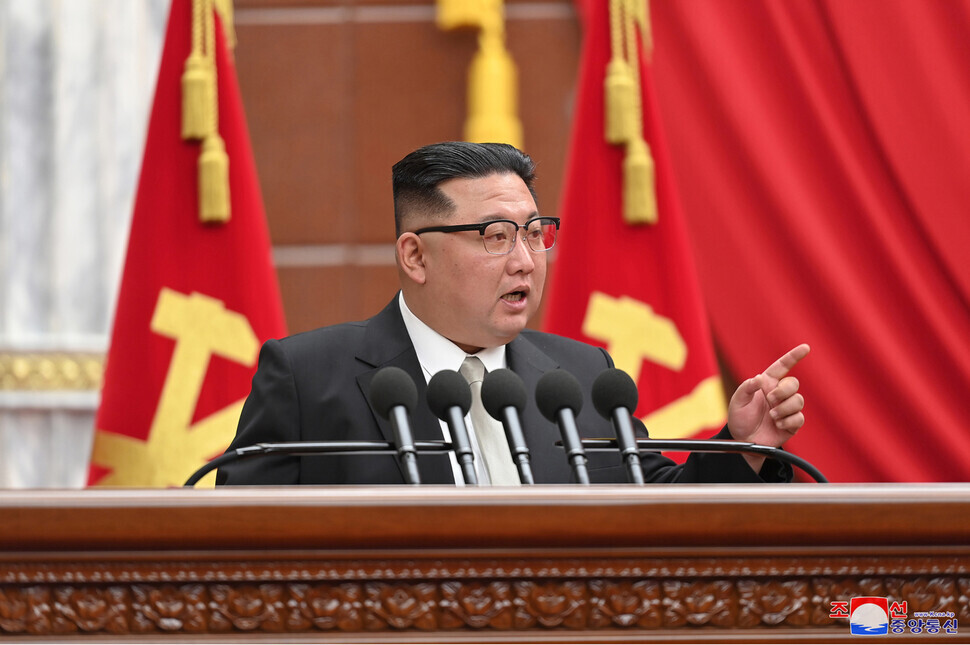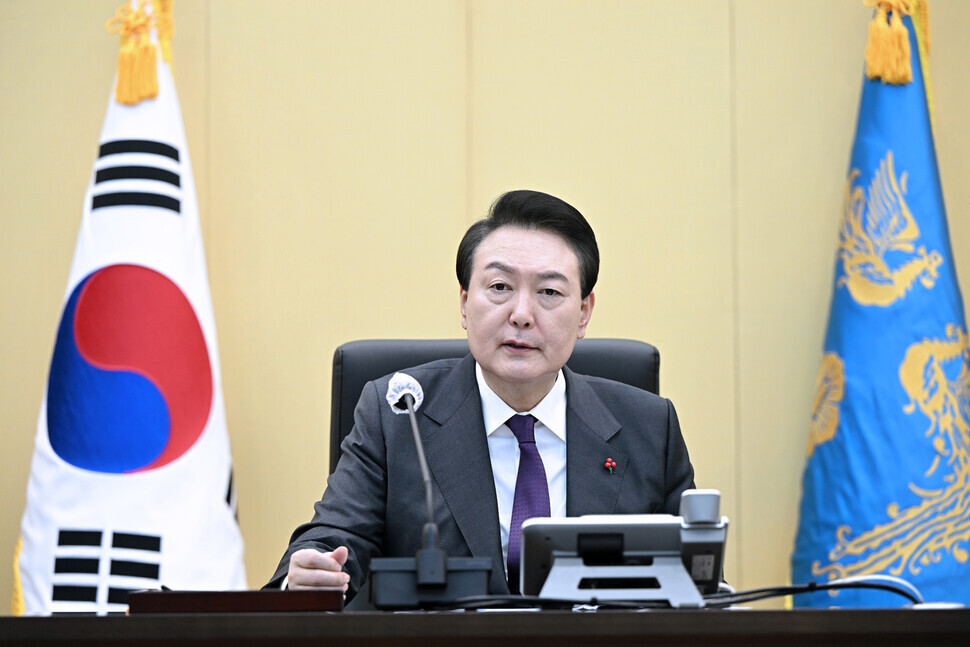hankyoreh
Links to other country sites 다른 나라 사이트 링크
Korean Peninsula rings in new year amid looming threat of military conflict

With the leaders of North and South Korea taking turns advocating for preparations for war as the two toe the line of full-frontal military conflict, the Korean Peninsula has rung in the new year at a time of soaring fears of armed hostilities.
North Korean leader Kim Jong-un called South Korea the North’s “undoubted enemy” at a plenary session of the 8th Central Committee of the Workers’ Party of Korea (WPK), held Dec. 26-31, going on to say it was “necessary to make the year 2023 [. . .] a year of bringing about a change in making preparations to mobilize for war and enhancing the actual war capacity” of the North’s forces.
The North Korean leader made mention of Pyongyang’s ability to put all of South Korea within range of tactical nuclear weapons by mounting them on rockets meant for super-large rocket launchers.
In response, President Yoon Suk-yeol of South Korea said on the phone with major military commanders that the South’s forces “must surely retaliate against any enemy provocation with the determination to participate in war if need be.”
The Ministry of National Defense and the Joint Chiefs of Staff released press statements after the fact emphasizing that they would participate in war if need be, and that any attempt by North Korea to use nuclear weapons would bring an end to the Kim Jong-un regime.
On the same day, Kim put forth a belligerent and hostile policy line toward South Korea.
The WPK-run Rodong Sinmun reported on Sunday that Kim stated that ”the south Korean puppet forces [. . .] have come out as our undoubted enemy,” and also called for “an exponential increase of North Korea’s nuclear arsenal,” as the foundation for “clarifying the epochal strategy of the development of nuclear force and national defense for 2023 with this as a main orientation.”
In a speech on the deployment of 30 super-large 600mm multiple rocket launchers that was held at the headquarters of the WPK in Pyongyang on Saturday, Kim Jong-un said the rockets would be capable of carrying tactical nuclear warheads that put all of South Korea in their range.
Next, a long-range artillery unit in the North Korean military’s western region fired one round from a super-large multiple rocket launcher toward the East Sea early on Sunday morning, according to a report by the state-run Korean Central News Agency.

South Korea’s Joint Chiefs said they had detected one short-range ballistic missile being launched from the Yongsong area of Pyongyang around 2:50 am on Sunday.
North Korea revealed it had developed super-large multiple rocket launchers to the outside world at the time of their first test launch in August 2019. While it would be theoretically possible for those rockets to be nuclear-tipped, that’s not yet feasible for North Korea considering it hasn’t completed nuclear warhead miniaturization.
On Sunday, the leaders of both Koreas stressed “war” instead of “dialogue.” Kim didn’t even use the word “dialogue,” and Yoon made no mention of inter-Korean relations in a message released for the New Year. That indicates that, at least for now, neither leader is interested in or hopeful about dialogue or negotiations.
“Our nuclear force considers it as the first mission to deter war and safeguard peace and stability,” Kim said. “However, if it fails to deter, it will carry out the second mission, which will not be for defense.”
The Rodong Sinmun reported that Kim had also set “a task [. . .] to develop another ICBM system whose main mission is [a] quick nuclear counterstrike.” By deliberately making these remarks public, Kim was attempting to elevate the “deterrence credibility” of his plan to strengthen the North’s nuclear counterstrike capability, which would include aiming tactical nuclear weapons at South Korea.
When Kim Jong-un encouraged scientists to develop “another ICBM system,” he was referring to a solid-fuel propulsion system.
“The National Aerospace Development Administration will launch the first military satellite of the DPRK at the earliest date possible,” the North Korean leader also said.
“Our military must clearly retaliate against any provocation by the enemy in full readiness to engage in combat,” Yoon said on Sunday, speaking to military commanders including Kim Seung-kyum, chairman of the Joint Chiefs of Staff. South Korea’s Ministry of National Defense and Joint Chiefs followed up with press releases emphasizing readiness to engage in battle.
“We offer North Korea a stern warning that if it attempts to use nuclear weapons, the Kim Jong-un regime will meet its end,” the Defense Ministry said.
Kim Seung-kyum paid visits to units on the western front and air defense units in the capital region on Sunday afternoon, reviewing their operational alertness and stressing the need for military readiness to engage in combat.
Army Chief of Staff Park Jeong-hwan of South Korea made an unplanned visit on Sunday to the special mission brigade, which is currently drilling special operations deep in enemy territory. “Concentrate on these exercises so that you may arouse fear and trembling in the enemy as the key unit for making an overwhelming response,” Park told the troops.
The special mission brigade is an elite unit that would be inserted in Pyongyang and other areas in the heart of North Korea in the event of a war to destroy critical facilities and eliminate key figures.
Yoon had emphasized “overwhelmingly superior war preparations” during a visit to the Agency for Defense Development on Dec. 29; the following evening, the South Korean Defense Ministry carried out a test flight of a solid-fuel space vehicle.
Kim Jong-un also “put forward [. . .] detailed orientations of responding to the US and other enemies [. . .] on the principle of power for power and head-on contest,” the Rodong Sinmun reported.
The US, Kim said, is “working hard to establish a new military bloc like [an] Asian version of NATO under the signboard of ‘tightening [the] alliance.’” He added that “South Korea is [. . .] busying itself with hostile military moves to pose a confrontational challenge.”
“The prevailing situation calls for making redoubled efforts to overwhelmingly beef up the military muscle [. . .] in response to the worrying military moves by the US and other hostile forces,” the North Korean leader went on to say.
The North’s leader also mentioned “the evident switch of the structure of international relations to the ‘new Cold War’ system and the accelerating current of multipolarization.” Since dialogue and negotiations with the US and South Korea are impractical from this perspective on current developments, they’re bound to be pushed to the back burner in North Korean policy as well.
The Korea Institute for National Unification said that “2023 could go down as the most perilous year in history for the North Korean nuclear program” in a recently published report detailing projections for developments on the Korean Peninsula this year.
Experts advise that Yoon and Kim moderate their words and actions to contain the situation on the Korean Peninsula, so as to ensure that an emotional exchange of hard-line comments doesn’t cause the two sides to climb the “ladder of escalation.”
“For the time being, it’s important that military tensions not be elevated on the Korean Peninsula,” said Cheong Wook-sik, director of the Hankyoreh Peace Institute. “The leaders of both South and North Korea need to focus on crisis management and situation management, including the issue of communication, to ensure that military tensions don’t rise.”
By Lee Je-hun, senior staff writer; Kwon Hyuk-chul, staff reporter
Please direct questions or comments to [english@hani.co.kr]

Editorial・opinion
![[Editorial] Yoon must halt procurement of SM-3 interceptor missiles [Editorial] Yoon must halt procurement of SM-3 interceptor missiles](https://flexible.img.hani.co.kr/flexible/normal/500/300/imgdb/child/2024/0501/17145495551605_1717145495195344.jpg) [Editorial] Yoon must halt procurement of SM-3 interceptor missiles
[Editorial] Yoon must halt procurement of SM-3 interceptor missiles![[Guest essay] Maybe Korea’s rapid population decline is an opportunity, not a crisis [Guest essay] Maybe Korea’s rapid population decline is an opportunity, not a crisis](https://flexible.img.hani.co.kr/flexible/normal/500/300/imgdb/original/2024/0430/9417144634983596.jpg) [Guest essay] Maybe Korea’s rapid population decline is an opportunity, not a crisis
[Guest essay] Maybe Korea’s rapid population decline is an opportunity, not a crisis- [Column] Can Yoon steer diplomacy with Russia, China back on track?
- [Column] Season 2 of special prosecutor probe may be coming to Korea soon
- [Column] Park Geun-hye déjà vu in Yoon Suk-yeol
- [Editorial] New weight of N. Korea’s nuclear threats makes dialogue all the more urgent
- [Guest essay] The real reason Korea’s new right wants to dub Rhee a founding father
- [Column] ‘Choson’: Is it time we start referring to N. Korea in its own terms?
- [Editorial] Japan’s rewriting of history with Korea has gone too far
- [Column] The president’s questionable capacity for dialogue
Most viewed articles
- 1Months and months of overdue wages are pushing migrant workers in Korea into debt
- 2Trump asks why US would defend Korea, hints at hiking Seoul’s defense cost burden
- 3[Editorial] Yoon must halt procurement of SM-3 interceptor missiles
- 4At heart of West’s handwringing over Chinese ‘overcapacity,’ a battle to lead key future industries
- 5[Guest essay] Maybe Korea’s rapid population decline is an opportunity, not a crisis
- 6Fruitless Yoon-Lee summit inflames partisan tensions in Korea
- 7First meeting between Yoon, Lee in 2 years ends without compromise or agreement
- 8Dermatology, plastic surgery drove record medical tourism to Korea in 2023
- 9Under conservative chief, Korea’s TRC brands teenage wartime massacre victims as traitors
- 10Anti-immigration candidate marauds across Korea with squad detaining foreigners